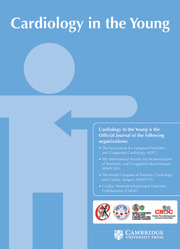Each successful department will have its quota of shooting stars. The same departments will have those who function as the concrete to ensure that the stars have the necessary support at ground level. Sometimes the star in question can also be an integral part of the foundation. Sang Park was such a star. His name is probably not as well known as it ought to be. Those who now work in the field of paediatric cardiology can be forgiven if they forget how young is the specialty. Indeed, it can now be argued that the field is the sum of a set of sub-specialties. In the good old days, when the stethoscope was a diagnostic modality rather than an ornament, the best practitioners in the field straddled all the sub-specialties. Sang also satisfied this criterion. He learned his trade at the feet of the founders of our specialty, and counted among his many friends those who instituted the widening of the specialty (Figure 1).
He was born in Seoul, in what was then simply Korea, just before the outbreak of the Second World War. He received his initial training at the Catholic Medical College in Seoul, graduating in 1963. After his initial internship of one year in Korea, he journeyed to the United States, where he was accepted for an internship at Bergen Pines County Hospital, in Paramus, New Jersey. From there, he was accepted for training in paediatrics at Mount Sinai Hospital in New York. Advancing to become chief resident by 1968, he then embarked on training programme in paediatric cardiology under the direction of Leonard Steinfeld, progressing to “finishing school” at Johns Hopkins, where the directorship of the department had passed from Helen Taussig (Figure 1) to Dick Rowe, prior to Dick himself transferring to Toronto.
By now the relatively finished product, in June of 1972, he was appointed to the Division of Pediatric Cardiology at Children’s Hospital of Pittsburgh, where Bob Zuberbuhler was building up a new team. Joined at more-or-less the same time by Bill Neches, who had trained in Houston, the three sowed the seeds for the development of what is now a stellar institution. One of us trained under their guidance. The other was fortunate to benefit from all the very best of the fruits of their endeavours. Under the joint supervision of the triumvirate, Pittsburgh advanced to become all that is good about paediatric cardiology and paediatric cardiac surgery. Sang spent the remainder of his career continuing to do good things for Pittsburgh and for those working in centres less well-resourced. In all, he spent 36 years in the division before retiring in 2008. As emphasised in the recent announcement of his passing to the current members of the team, he served as a beacon of knowledge and compassion, touching the lives of countless patients, families, and colleagues.
Always an innovative thinker, he developed several novel techniques that significantly advanced the care of children with complex CHDs, including the Park blade atrial septostomy catheter, and a percutaneously adjustable pulmonary band to be used in the operating room. He was leader of the catheterisation laboratory, and initial director of echocardiography, but first and foremost he was beloved for his tireless commitment to his patients and their families. His passion for teaching had a great and lasting impact on hundreds of paediatric residents and cardiology fellows. These passions, however, are only part of his remarkable legacy. He was a true humanitarian. Deeply devoted to his faith, he was a leader in medical missions to under-privileged children in Guatemala and Africa. He led many medical missions to Malawi, where there is now a home for orphans and vulnerable children dedicated in his honour. He was also committed to sharing his Korean heritage and helped to create the Korean classroom in the Cathedral of Learning at the University of Pittsburgh. He always remained devoted to his family, particularly his wife for over 60 years, Sun, his daughter Audrey who is a paediatric allergist, son-in-law Brian, and grandson, Matthew. Sang will be deeply missed by all of those touched by his leadership, kindness, and friendship. Most of all, he was the epitome of what the English still continue to describe as a gentleman.
Competing interests
The authors have no disclosures to make
Funding statement
No funding was received to permit the writing of this obituary

Figure 1. Sang is shown with some of the founders of our specialty. In the top left hand panel, he is seen with Alex Nadas, and with Helen Taussig in the top right hand panel. In the lower left hand panel, he is seen with Chuck Mullins, while the lower right hand panel shows him, and his wife, with his great friend and colleague Bill Neches, along with his wife, and with one of the authors of this encomium and his better half.



